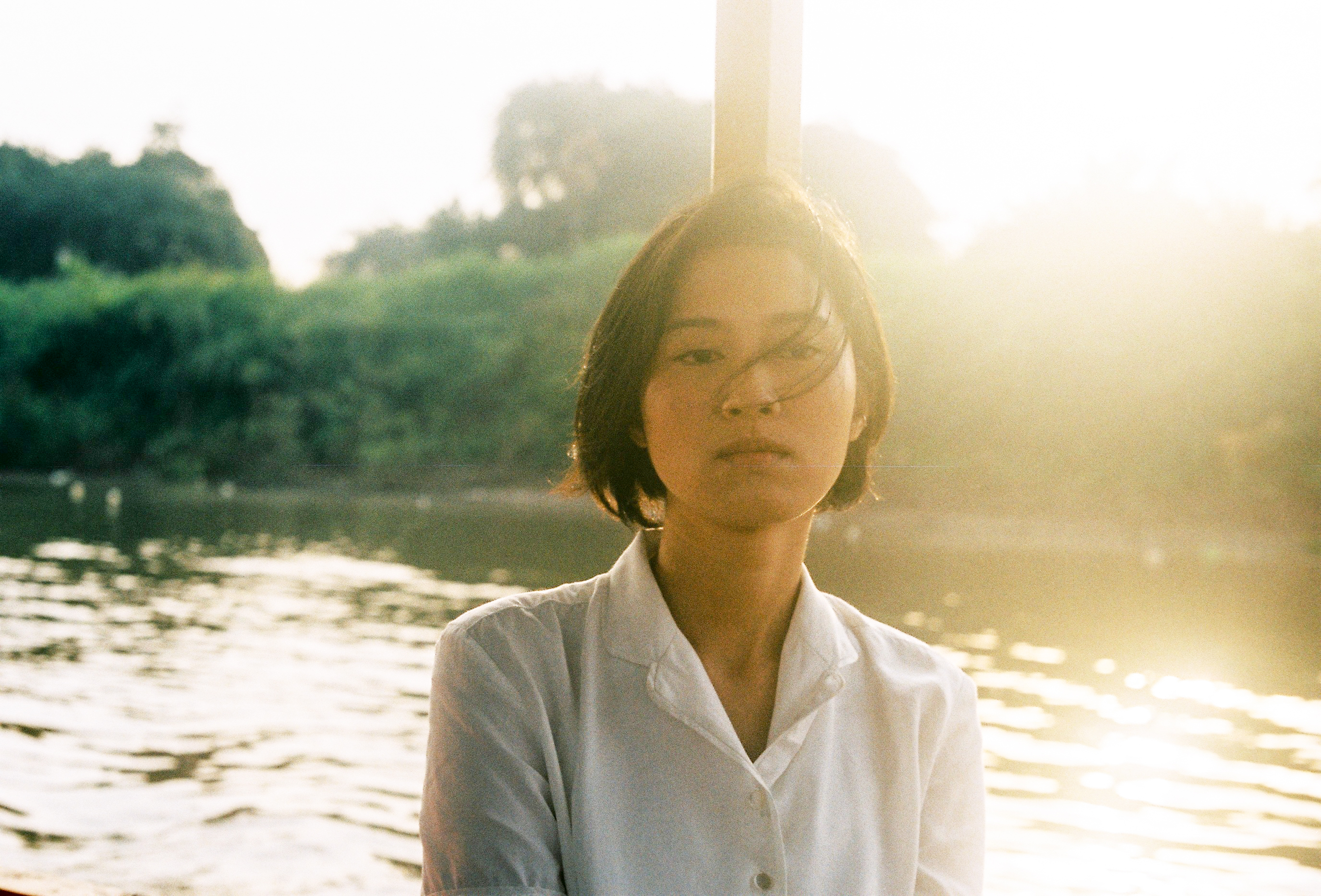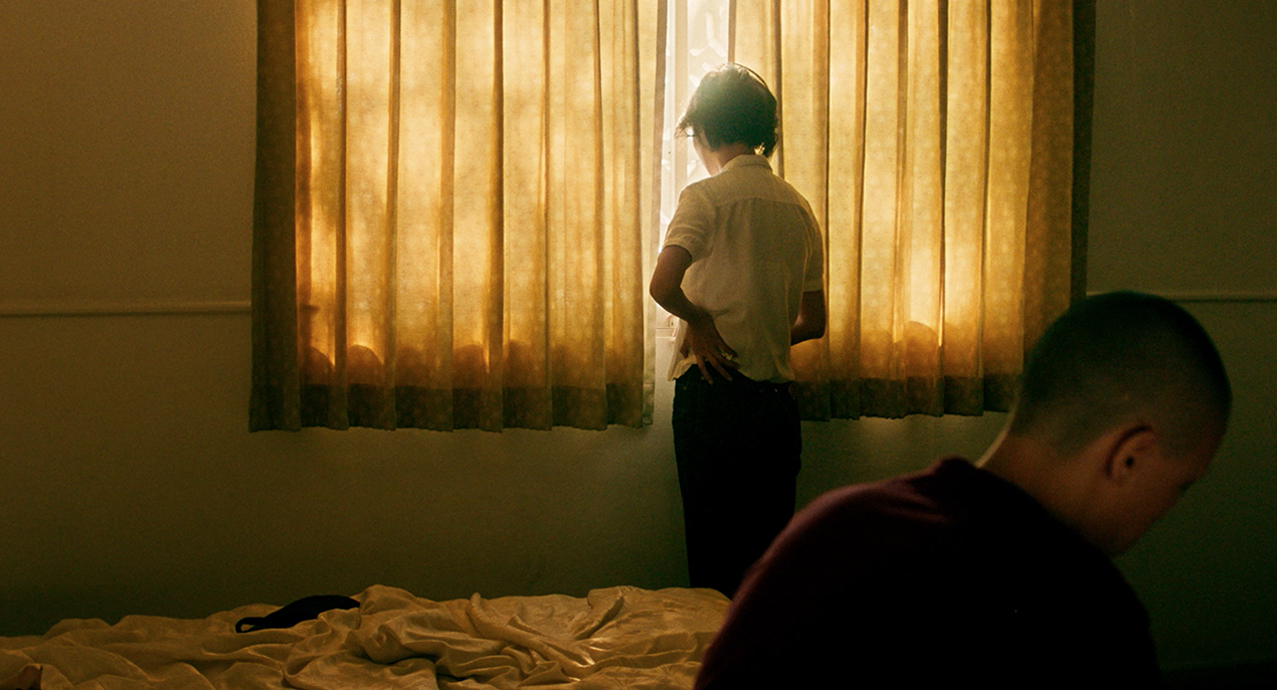YOUNG FILMMAKER PUANGSOI “ROSE” AKSORNSAWANG EXPLORED A HYBRID STORYTELLING IN HER FIRST FEATURE “NAKORN-SAWAN”
TEXT: PRATARN TEERATADA
(For English, please scroll down)
เรื่องราวเกี่ยวกับ “การส่งแม่ครั้งสุดท้าย” ของผู้กำกับหญิงที่น่าจับตามองอีกรายหนึ่งของวงการหนังไทย พวงสร้อย อักษรสว่าง (โรส) จาก profile ที่เคยเป็นผู้ช่วยกำกับหนังเรื่อง 36 ของ เต๋อ–นวพล ธำรงรัตนฤทธิ์ มีผลงานเขียนหนังสือพ็อกเก็ตบุ๊ค My Best Friend is Me และเรื่องสั้นอีกสองสามเรื่องซึ่งหนึ่งในนั้น นคร-สวรรค์ ได้กลายเป็นหนังยาวสร้างจริงในโปรเจ็คต์จบการศึกษาของโรสจาก University of Fine Arts of Hamburg อีกด้วย

ความน่าสนใจของ ‘นคร-สวรรค์’ อยู่ที่เทคนิคการเล่าเรื่องแบบ hybrid กึ่งดราม่า กึ่งสารคดี ซึ่งมีลักษณะทั้ง “จริง” และ “เหมือนแสดง” โรสถ่ายทอดความทรงจำของตัวเองที่มีต่อ แม่ พ่อ ป้า น้อง และผู้ชายคนหนึ่ง ออกมาแบบปะติดปะต่อไม่เป็นเส้นตรงคล้ายกับงานศิลปะ collage โดยอาศัย footage ที่เคยถ่ายเก็บไว้จริงๆ มาผสมกับงานเซ็ตถ่ายใหม่ เพื่อเล่าเรื่องของนักศึกษาศิลปะเอกฟิล์มชื่อ ‘เอย’ ที่เพิ่งกลับจากเยอรมันมาลอยอังคารของแม่ มีพ่อ ป้า ลูกพี่ลูกน้อง คนขับเรือ และกระดูกของแม่ล่องไปยังปากน้ำโพ (ชอบซับไตเติลภาษาอังกฤษใช้คำว่า mouth of Chao Praya ให้ความรู้สึกจริงอีกแบบ) ด้วยความเชื่อที่ว่าจะส่งวิญญาณแม่ไปสู่สวรรค์ เรือล่องพาทั้งคนและกระดูกไปส่งที่หมายอย่างเนิบช้า หลังจากนั้นแต่ละคนต่างแยกย้ายไปดำเนินชีวิตของตนพร้อมกับความทรงจำบางอย่างตามที่แต่ละคนเลือกที่จะเก็บมันเอาไว้ “ความทรงจำต่อใครสักคน” นับเป็น big message ที่ทรงพลังที่ถูกนำมาใช้ในหนังเรื่องแล้วเรื่องเล่า เที่ยวนี้โรสเลือกเล่าความสัมพันธ์ส่วนตัวของเธออีกครั้งในแบบ “ตัดแปะ” ทั้งส่วนที่เธอเลือกจดจำเอาไว้เองและส่วนที่ตามรบกวนใจอยู่แม้ไม่ได้เชื้อเชิญ (ถ้างานนี้เป็นสารคดีมันคงเป็นเรื่องจริง แต่อย่าลืมว่ามันมีโอกาสเป็นเรื่องแต่งด้วย มันจึงอาจเป็นกับดักให้ผู้ชมคล้อยตามไปก็ได้) ทั้งนี้เพราะมันคืองานจบการศึกษาของผู้กำกับเอง เลยต้องมีการใช้ทรัพยากรเต็มที่ทั้งส่วนที่เก็บไว้ในสต๊อกความทรงจำและบันทึกส่วนตัวที่ถ่ายเก็บไว้จริงๆ

ไฮไลท์ของ ‘นคร-สวรรค์’ สำหรับเราคือ งานภาพนิ่งที่โรสเซ็ตถ่ายของทำบุญบนโต๊ะเพื่อถ่ายทอดความทรงจำเกี่ยวกับแม่ออกมาได้ทรงพลัง โดยเฉพาะการเชื่อมต่อกับ time and space เข้าด้วยกัน (เข้าใจว่าถ่ายที่เยอรมัน) ประกอบกับบทสนทนาระหว่างแม่-ลูก เกี่ยวกับสารทุกข์สุขดิบ แฝงด้วยความห่วงใย ระคนกับความไม่เข้าใจนักในสิ่งที่ลูกทำแต่ด้วยความรักทำให้แม่เชื่อว่าลูกกำลังทำทำสิ่งดีๆ อยู่แน่นอน ซีนนี้จริงมาก กินใจมาก การถ่ายทอดที่มีความเหมือนจริงมากๆ อีกส่วนเห็นจะเป็นความทรงจำเกี่ยวกับพ่อ และสวนยาง ทั้งภาพและบทพูดดูจริงและมีพลังขับเคลื่อนมากที่สุดในเรื่องเลย สัญญะเกี่ยวกับยางยังปรากฏเป็นลายเส้นตรงบนแผ่นหลังของนางเอก ซีนนี้แอบอีโรติกและมิสติกในตัวแม้จะเป็นซีนสั้นๆ ความทรงจำเกี่ยวกับพ่อหวนกลับมาอีกครั้งในตอนท้ายๆ เรื่องยิ่งตอกย้ำความจริงของหนังเข้าไปอีกด้วยบรรยากาศของงานภาพก่อนจะมีแขนใครสักคนยื่นผ่านกล้องมาตบมือ คล้ายจะปลุกผู้ชมให้ ตื่นๆ กลับจากความจริงสู่ความทรงจำกันต่อดีมั๊ย……
 This story of the ‘last farewell to the mother’ is the work of an up-and-coming Thai female director, ‘Puangsoi Aksornsawang’ (Rose). Her impressive profile includes her role as an assistant director of ’36’, a film by Nawapol Thamrongrattanarit (Ter), and being an author of a pocketbook titled ‘My Best Friend is Me’ and a number of short stories one of which is ’Nakorn-Sawan’ whose story is expanded into a feature-length film Aksornsawang did as her thesis project at the University of Fine Arts of Hamburg.
This story of the ‘last farewell to the mother’ is the work of an up-and-coming Thai female director, ‘Puangsoi Aksornsawang’ (Rose). Her impressive profile includes her role as an assistant director of ’36’, a film by Nawapol Thamrongrattanarit (Ter), and being an author of a pocketbook titled ‘My Best Friend is Me’ and a number of short stories one of which is ’Nakorn-Sawan’ whose story is expanded into a feature-length film Aksornsawang did as her thesis project at the University of Fine Arts of Hamburg.

One of the interesting things about ‘Nakorn-Sawan’ is the hybrid storytelling technique it employs. The combined elements of drama/documentary bring the senses of ‘reality’ and ‘performing’ to the film. Aksornsawang transpires her own memories about her parents, aunt, cousins and a man in non-linear, collage-like storytelling. The film progresses like a piece of art made up of old footage she’s kept over the years and a number of newly-shot ones. It tells the story of a film student named ‘Aoei’, who comes back to Thailand from Germany for her departed mother’s ‘Loi Angkarn’ ceremony (the floating or scattering of the dead’s cremated ashes into the open water). Aoei, her father, cousins and a boat driver bring her mother’s relics on a boat ride to Pak Nam Pho (the English subtitle translates Pak Nam Pho area as the ‘mouth of Chao Phraya River’, which provides somewhat a realistic feel of where the ashes would be released into) with the belief that it is a way of sending her mother off to heaven. Riding slowing on the water, the boat takes the living and relics of the dead to the destination. The ceremony was completed as the people who are still alive go on with their lives with a fragment of memories they choose to keep with themselves. ‘A memory of someone’ is one of the big messages that has been in countless films. With ‘Nakorn-Sawan’, the director recounts the story of her personal relationship as a piece of collage, made of the memories she chooses to remember and those that keep coming back uninvited (with the film is a documentary/drama hybrid, viewers might at times be led to believe that what they’re watching are real-life story. But knowing that parts of the film are fiction, the whole storytelling might just be the director’s way of getting the audience to be emotionally engaged in the realistic elements of the film). With the film being Aksornsawang’s thesis project, it doesn’t hold back in using the director’s resources whether they are her own memories or old footage she personally documented.

The highlight of ‘Nakorn-Sawan’ (to me at least) is the photographs of the food meticulously prepared and arranged on a table as an offering for her late mother. They powerfully express the mother in Aoei’s memories, especially through the connection between time and space (from my understanding, the photographs were taken in Germany) with inserted conversations between the mother and daughter, from the casual ‘how are you?’ to concerns and worries. At times, we sense the mother’s incomprehension in what her daughter is doing, but also the love and trust in her decisions. The scene is so real and incredibly moving. Everything is portrayed so beautifully yet realistically. There are parts in the film that depict Aoei’s memories of her father and the family’s rubber plantation. The images and dialogues of this part are the most real and most dynamic of the entire film. A symbolic representation of rubber appears as a short, erotic and mystic scene depicting the straight lines on the protagonist’s back. Another piece of memory about her father makes its way back into the latter part of film, reassuring the realness of the story with the lingered visuals before we see someone’s hands come into the camera before a loud clap is heard, as we are awakened, wondering if we should leave the reality behind and find our way back into memories once again…

